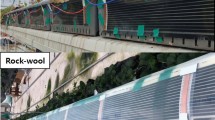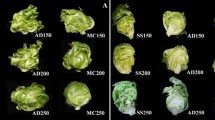Summary
The results of this project show that best yields, best color, best quality and best texture are obtained when rhubarb is grown at a temperature ranging from 55°–60° F (12,8°–15,5° C). At lower temperatures the growth will be very slow, and at higher temperatures the growth will be fast but the texture poor.
Temperature affects both the yields and color of forced rhubarb. At high temperatures with low moisture, the roots become exhausted more quickly and the plants are more susceptible to soft rot. The rate of growth of forced rhubarb is directly proportional to the air and soil temperature, and the first few pickings are not greatly affected by other growth factors. Media with higher water-holding capacity and consequently a lower temperature, should be avoided. The color of forced rhubarb is an important factor in marketing. A dark red color is preferred, although a pink is very desirable. If a good red strain of rhubarb is planted, the forced product will be red what ever the temperature, but other strains lose their color if temperature is over 60° F (15,5° C).
Best vigour and stability in growth is found in larger roots with a greater amount of food reserve. The freezing of roots before forcing is also very important, and can be done by natural freezing as well as by chemical treatment, and should be combined with a long rest period after freezing.
This test agrees with the results obtained in previous works on this subject, but more detailed work taking into consideration the effect of air and soil temperature as well as moisture, treatment period, age of root, degree of dormancy, sugar content in the petioles as affected by all above mentioned factors, susceptibility to disease, etc. should be done before it can be used as an absolutely reliable test for commercial rhubarb forcing.
Similar content being viewed by others
References
Bjornseth, E. H., 1946a. The effect of bottom heat on the yield of forced rhubarb.Amer. Soc. hort. Sci. 48,363–368.
Bjornseth, E. H., 1946b. The effect on yield of freezing and various ethylene treatments in breaking the dormancy of rhubarb.Amer. Soc. hort. Sci. 48369–373.
Hepler, G. R., 1928. The effects of ether and various temperatures in forcing rhubarb.Proc. Amer. Soc. Hort.
Hammersly, R. W., 1913. Experiments in forcing rhubarb. Unpublished thesis. University of Wisconsin. 1913.
Sayer, C. B., 1927. Winter forcing of rhubarb.Ill. Agri. Exp. Sta. Bull. 298;58–76.
Author information
Authors and Affiliations
Rights and permissions
About this article
Cite this article
Obolensky, G. Studies in forcing rhubarb. Plant Food Hum Nutr 7, 241–246 (1960). https://doi.org/10.1007/BF01099769
Issue Date:
DOI: https://doi.org/10.1007/BF01099769




